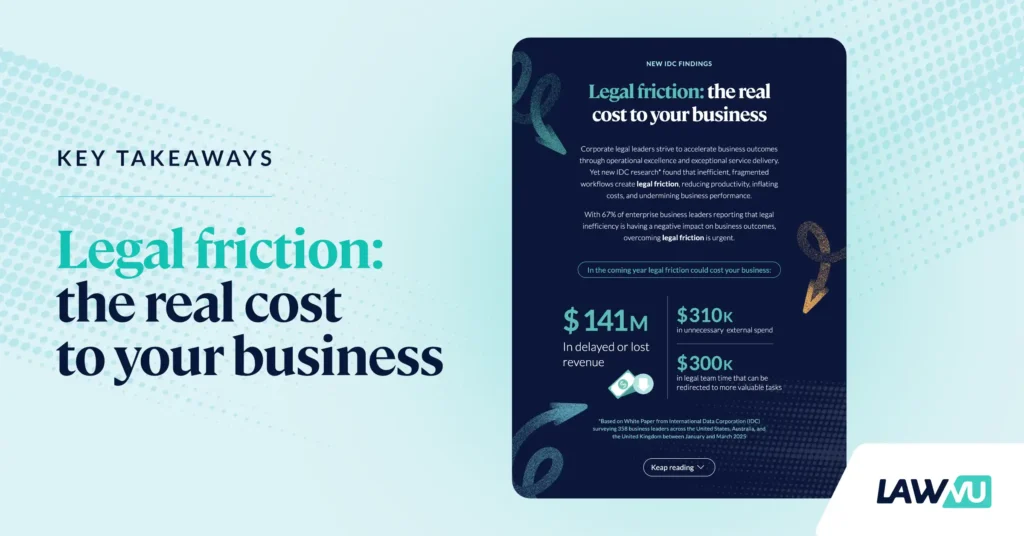Legal friction: The real cost to your business

Breakdown of IDC White Paper sponsored by LawVu, Legal Friction: The Real Cost to Your Business, May 2025.
New research by IDC exposes the millions in operational costs shouldered by businesses as a result of under-resourced in-house legal teams – and presents a critical opportunity for organizations to drive revenue by investing in legal as a powerful accelerator of growth.
As an enabling partner which is connected to multiple departments, a fully optimized legal function should act not as an impediment to the business, but as an accelerator: supporting core functions, unlocking opportunities to scale, and driving strategic initiatives forward at pace.
As the complexity and volume of work performed by in-house legal teams continues to expand, the role these functions play within their wider organizations has never been more pivotal.
With the right operational foundations, legal can become a key driver of revenue and a source of competitive advantage for the business.
However, new research – sponsored by LawVu and conducted by the International Data Corporation (IDC) – reveals that, for many enterprises, this is not currently the case.
To download your copy of the IDC White Paper, click here.

From friction to force multiplier
With practical tips on evaluating and adopting legal tech. Hear from industry experts and learn how modern legal teams use tech to reduce friction and drive better business outcomes.
IDC research study findings: At a glance
The IDC White Paper, based on research conducted across the United States, Australia and the United Kingdom from January to March 2025, captures 358 first-hand experiences of both in-house legal leaders and the heads of peer functions within their organizations who rely on them most – from sales and marketing to IT and R&D and the executive suite.
At a glance, the White Paper signals that:
- Inefficient processes are stifling the potential of in-house legal teams. Legal teams are struggling to meet the demands of the business and fulfil their roles as strategic partners thanks to widespread legal friction: inefficient manual and administrative workflows which undermine productivity, inflate costs and hinder high-impact work.
- Legal friction comes at a quantifiable cost to the business. Inefficient legal processes have a measurable impact on the bottom line, costing businesses millions every year in wasted time, outsourcing costs, lost revenue generation opportunities and reputational damage.
- By addressing legal friction, businesses stand to unlock significant gains. The root cause of legal friction is procedural inefficiency – and it’s a problem with a clear solution. By prioritizing investment in legal operations, organizations have an opportunity not only to save money, but to up the pace and credibility of their wider businesses at the same time.
A critical opportunity for business leaders…
Until now, investment in the legal department has been a low priority for many organizations, with legal teams deprived of the operational and technological resources that have long been utilized by their peer functions.
The White Paper paints a stark picture of what happens when legal teams are not afforded the resources required to perform their critical roles at the heart of their organizations – and for CEOs, CFOs, GCs and executive decision makers, it marks an urgent opportunity.
By investing in their legal operations and leveraging in-house legal technology to automate manual workflows, standardize processes and facilitate self-service capabilities, business leaders can address the root causes of legal friction head on – empowering in-house legal teams to become a more productive and strategic asset to their organizations.
… and in-house legal teams
The many sources of legal friction identified in the White Paper do not reflect failings on the part of in-house legal teams themselves, who consistently emerge from the research as a highly capable, strategically driven arm of the business.
For senior legal counsel and in-house legal leaders who are stretched thin by growing business demands, the findings in this paper should provide reassurance that they are not alone in the challenges they face.
For these leaders, the results also present a tangible opportunity: by leveraging the data in this paper, which clearly identifies the causes and impacts of legal friction across a wide range of enterprises and industries, in-house legal teams can build a compelling case for investment.
What is legal friction?
“67 percent of business leaders report that ineffective and inefficient legal processes negatively impact business outcomes.” – IDC
Legal friction is the operational drag created by inefficient processes within in-house legal teams.
This friction (which is caused by reliance on manual processes, fragmented workflows, multiple channels of communication, and a lack of data-driven in-house legal technology) consumes the capacity of legal, slows down service delivery and restricts the ability of in-house lawyers to focus on strategic work.
The impact of legal friction isn’t just felt within in-house legal teams. It causes a loss of momentum across the entire business, slowing down project turnaround times, eroding internal confidence in the legal department and undermining financial performance.
Legal friction: In numbers
Legal friction costs businesses* on average:
| USD $141 million per year in lost or delayed revenue | USD $310,000 per year in unnecessary outside counsel costs | Up to USD $300,000 per year in time wasted by legal on low-value tasks |
*Businesses surveyed with mean revenue of over USD $1 billion per annum.
The financial, operational and reputational impacts of legal friction
The white paper uncovers the measurable revenue losses and widespread operational disruptions caused by in-house legal inefficiencies, underscoring a challenge that extends beyond internal frustration to affect overall performance, profitability and brand.
Here’s the breakdown:
The financial cost of legal friction
The white paper confirms that the financial cost of legal friction is staggering. The IDC data shows:
Delayed or lost revenue
Slow legal processes are directly undermining revenue opportunities, with delays to sales contracts, product launches and marketing campaigns all proving costly to the business.
- Two-thirds of business leaders confirm that inefficient in-house legal processes have resulted in delayed or lost revenue for their departments over the past 12 months – with 60 percent of legal leaders acknowledging the same issue.
- On average, business leaders estimate that 11 percent of revenue is being lost or delayed every year as a result of legal inefficiencies. For businesses with a mean revenue of over USD $1 billion per year, this amounts to a loss of USD $141 million in annual revenue.
Wasted time
As workloads grow in bulk and complexity, time is one of the legal function’s most precious assets – and a significant amount is being wasted due to inefficient legal processes.
- 83 percent of in-house legal leaders surveyed report that manual administrative tasks prevent them from focusing on strategic work, and 53 percent of corresponding business leaders agree that their own teams are wasting too much time managing legal requests.
- Manual, low-value work is consuming, on average, at least one day per week for members of in-house legal teams. This time is worth an average of up to USD $300,000 per year per organization surveyed.
Inflated outside counsel costs
Outside counsel costs remain one of the largest outgoings for legal teams and their businesses, with external rates reaching up to ten times those of salaried lawyers. ACC figures indicate that 47 percent of legal budgets were allocated to outside counsel in 2024. IDC research shows:
- 72 percent of in-house legal counsel report having to outsource work to outside counsel due to lack of bandwidth, with 55 percent of business leaders admitting to the same.
- Overall, respondents admit to outsourcing an average of 17 percent of their legal work unnecessarily every year, equating to up to USD $310,000 annually in wasted legal spend.
Taken cumulatively, the data confirms that legal friction is imposing significant and unnecessary financial costs on businesses. But it also presents a compelling opportunity: the shared experiences expressed by legal and non-legal respondents alike signpost a clear path to securing better value.
By improving legal processes, businesses have a golden opportunity to not only combat inefficiency, but to measurably impact their bottom line – to the benefit of stakeholders on all sides.
The operational cost of legal friction
The research indicates that the direct financial costs of legal friction are just the tip of the iceberg.
The IDC data also points to a raft of secondary impacts that compromise operational performance – impacts which, because they are dispersed across the multiple departments that rely on in-house legal teams, are only visible from the perspective of the wider organization.
In addition to the financial cost of delays to vital deals and projects, IDC survey responses from business leaders across sales, marketing, R&D, IT, HR and executive teams show:
Technology procurement delays
- Two-thirds of business leaders report that the procurement or deployment of technologies for their departments has been delayed due to legal processes, with a knock-on effect on efficiency and productivity across various parts of the business.
Talent hiring difficulties
- 49 percent of business leaders report having been unable to hire the talent they need for their departments due to inefficient legal processes, exacerbating the ongoing challenge faced by many in attracting quality candidates to remain competitive in the market.
Project delays
- 34 percent of business leaders cite delays to projects or deadlines as a result of legal friction, with up to 12 percent of projects within individual teams not started or completed due to legal inefficiency within the past 12 months.
There’s no argument on this front from in-house legal respondents – 83 percent agree that inefficient processes are negatively impacting their ability to deliver legal services in a timely manner. Once again, while these stats confirm the deeper impact of legal inefficiency on broader business outcomes, they also amplify the potential gains to be secured by a better optimized legal function.
The reputational cost of legal friction
Inefficient legal processes affect the way that everyone, from internal stakeholders to the external market, perceives an organization. The IDC data reveals that business leaders are currently experiencing myriad pain points when interacting with their own in-house legal teams, such as:
Negative experience of in-house legal teams
- Only 1 out of 5 business leaders believe that their legal departments are very effective in supporting business objectives. A further 41 percent are concerned that delays in the legal review process are actively reducing productivity and morale within their own departments.
- At a micro level, business units report a number of negative interactions with their in-house legal teams, including slow turnaround, poor communication and lack of visibility into the progress of legal requests.
- When asked what they believe to be the underlying causes of these pain points, business leaders overwhelmingly cite a lack of technology: 41 percent cite issues with having to work across multiple and disparate software systems; 31 percent express dissatisfaction with the lack of self-service capabilities on offer for managing simple legal requests; 29 percent complain of the lack of tech-automated legal processes in general.
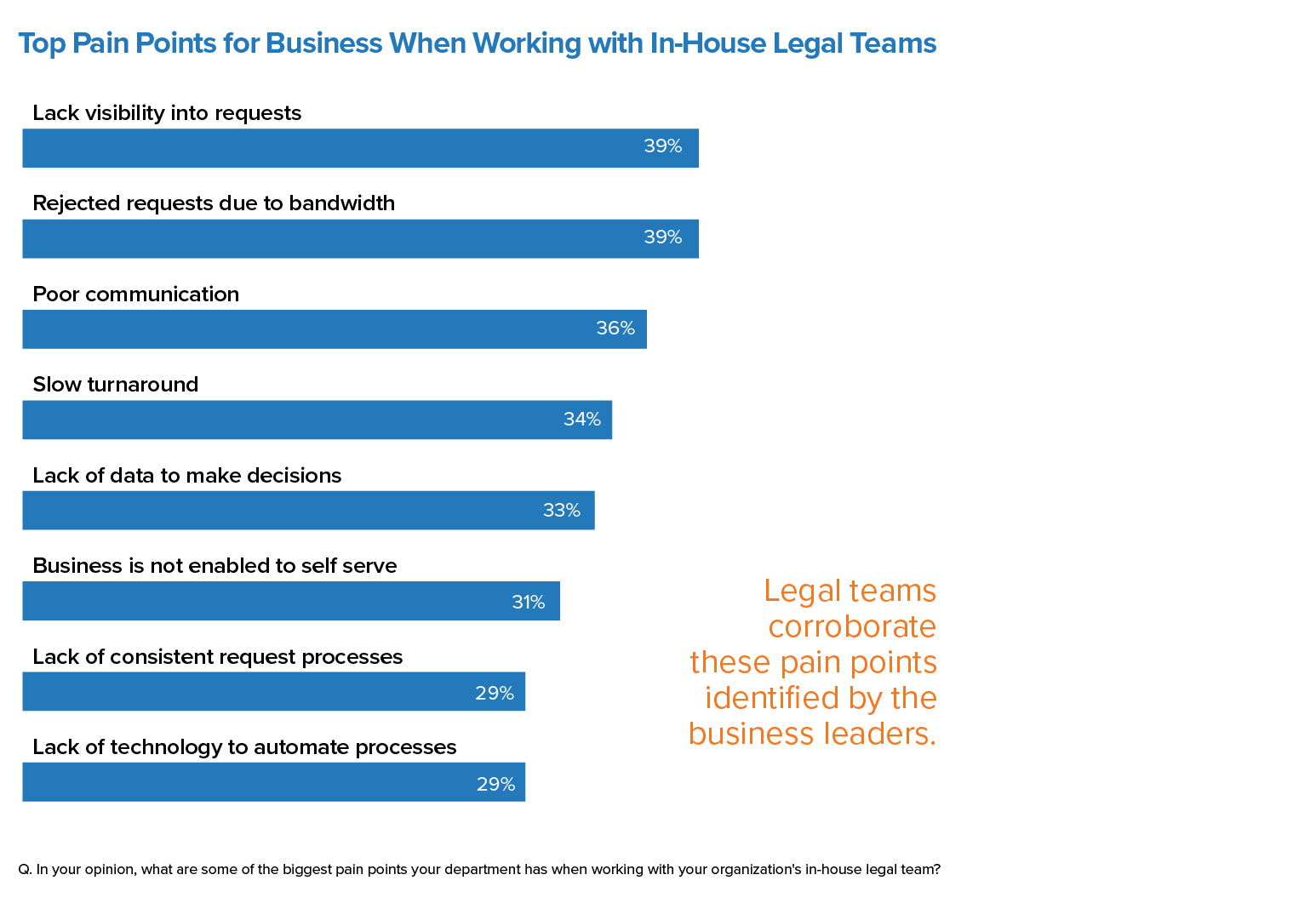
Bypassing of in-house legal teams
- With business leaders clear that many aspects of their current legal processes leave much to be desired, some are taking matters into their own hands. 70 percent admit that these pain points have, and will lead them to circumvent legal altogether, opening the door to serious compliance risk and increased exposure to litigation for the business.
Erosion of customer trust
- The effects of legal friction extend beyond the front door of the business. 73 percent of business leaders report receiving customer complaints due to legal process delays (including delays in the completion of sales contracts and launches of new products and services). It is likely that some of these complaints will have revenue ramifications.
At a time when expectations of legal service delivery are expanding, the IDC responses show that legal friction carries a reputational cost which proliferates far beyond the walls of in-house legal teams.
The good news is that, by removing legal friction businesses have an opportunity to resolve the problem upstream, allowing in-house legal teams to shed negative perceptions and gain recognition as accelerating partners for the wider organization at the same time.
Click here for a downloadable cheat-sheet on how legal friction may be affecting your business.
Legal friction is an urgent problem
It’s clear that legal friction is already hitting businesses where it hurts.
However, as broader industry research by ACC confirms that CLOs now rank operational efficiency as their chief strategic priority and consider understaffing to be their biggest challenge, it’s evident that the demands faced by in-house legal teams are growing – and fast.
IDC data confirms that just 37 percent of respondents feel they have adequate resources to keep up with demand, citing increasingly broad and complex workloads as their biggest challenge.
As respondents from in-house legal teams confirm that two of their top goals for the coming years are to increase both the size and efficiency of their departments to allow them to handle increasing volumes of work, there’s no doubt many legal functions will soon be expected to deliver services at a greater scale than ever before.
With teams struggling under their current workloads, it’s difficult to see how these goals can be achieved without investment into more efficient legal processes and technology.
All of this reinforces the urgent need for businesses to invest in a better approach to their legal operations – sooner rather than later.
Delay costs the business money
Every day, in-house legal teams hemorrhage money thanks to inefficient manual and administrative workflows – and as demand increases, these costs continue to increase.
To find out how much time your legal team is losing to inefficient workflows – and how much this legal friction currently costs your business –try out our legal friction calculator.
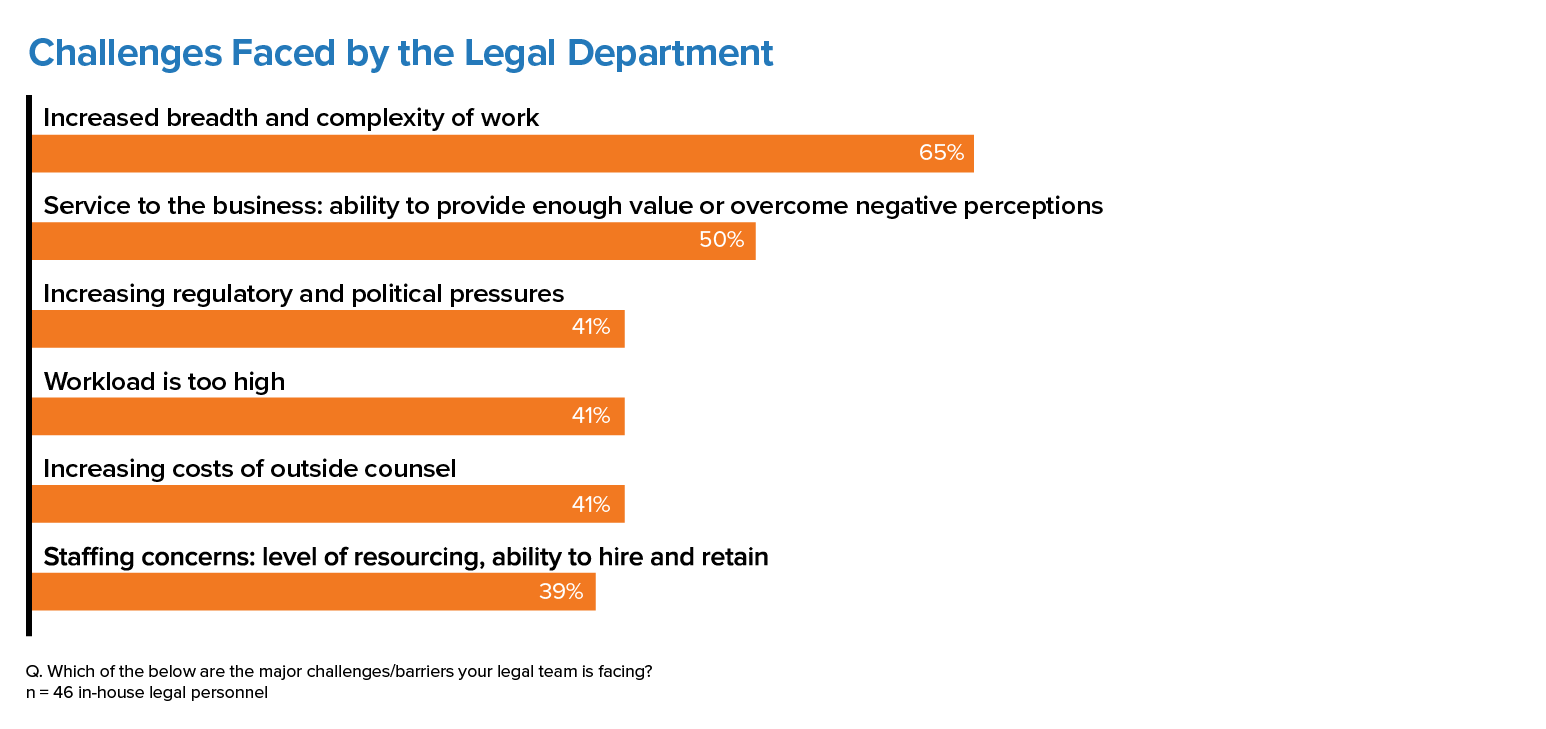
What’s causing legal friction?
The IDC white paper identifies several root causes of legal friction. Overall, the responses confirm that legal friction results, above all, from inefficient processes and under-investment in fit-for-purpose in-house legal technology.
Here are the biggest causes of legal friction:
Time-consuming manual processes
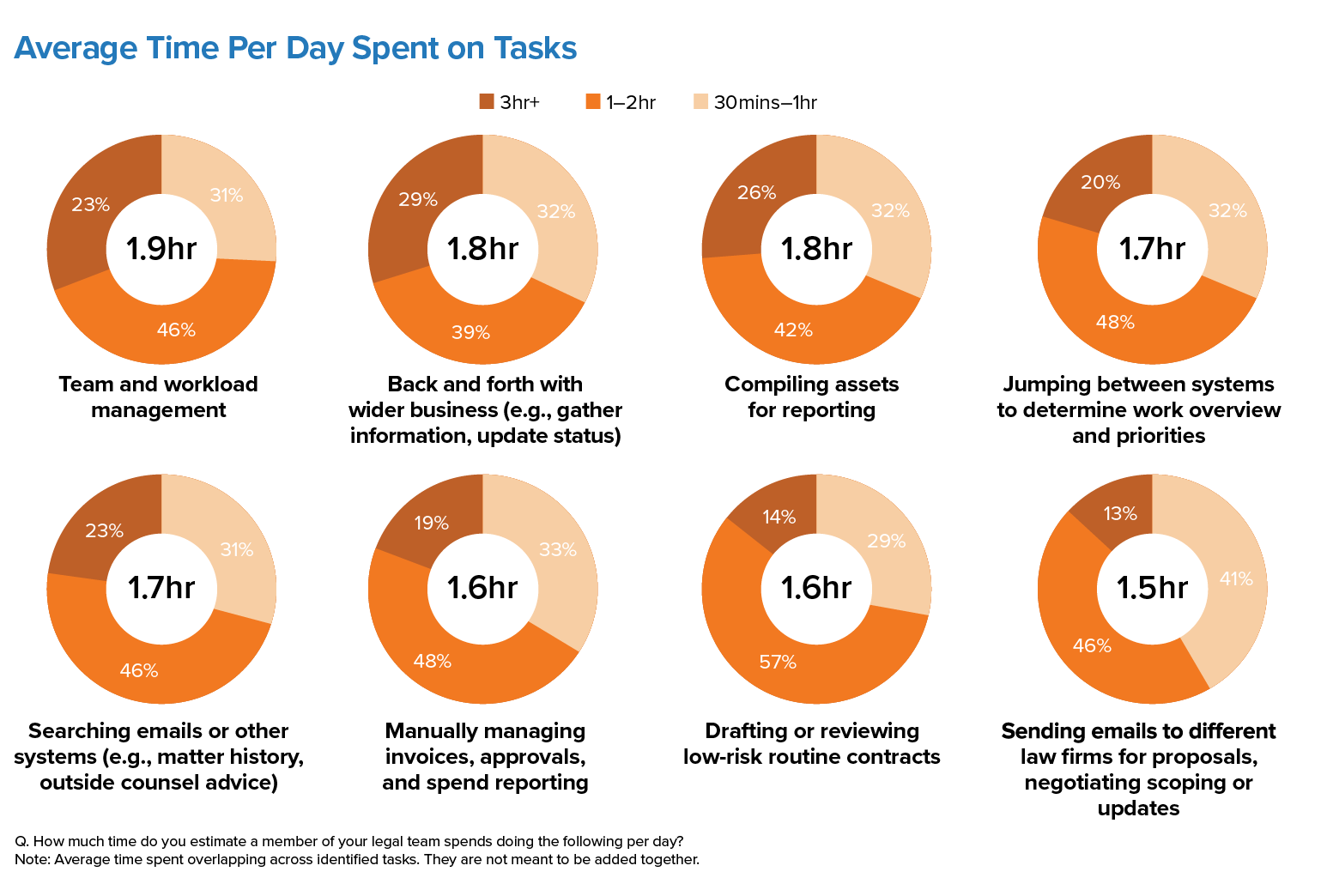
With workloads on the rise, it comes as no surprise that in-house legal teams are struggling for bandwidth. Only 37 percent are confident that they have adequate resources and staff to meet organizational demands, while 83 percent say manual administrative tasks prevent them from spending time on more strategic work for the organization.
The research reveals that, on average, in-house legal teams spend:
- Almost two hours per day going back and forth with the wider business, compiling assets for reporting, and managing their own teams and workloads.
- Over 90 minutes per day jumping between systems, searching emails, manually managing invoices, drafting or reviewing low-risk contracts, and emailing law firms about RFPs.
These numbers point to a colossal number of wasted hours every week, month and year for the average in-house legal team, adding up to a real cost to the business that could otherwise be saved.
And with business leaders reporting scattered communication, lack of self-service and inefficient tools as the biggest causes of inefficiency they experience when working with legal, the data confirms, from both sides of the business, that the tasks currently causing the most legal friction are also those that are most ripe for optimization through innovation, training and technology.
Fragmented workflows
Many legal teams still operate without standardized workflows, instead reliant on email, spreadsheets and basic word processing and chat systems. This makes it difficult to keep track of requests and supporting documents, contributing to delays in turnaround time, errors, and friction between departments.
IDC research reveals that:
- 50 percent of legal stakeholders cite scattered communication across multiple channels as the top cause of inefficiency in their interactions with other departments.
- 40 percent of legal stakeholders cite having to navigate multiple, disparate pieces of software to manage legal requests as the biggest contributor to inefficiency when working with the business.
As well as the obvious implications for productivity across the business, the absence of standardized legal procedures can also lead to miscommunication and heightened compliance risk, all of which in turn have a negative impact on organizational performance and reputation.
Insufficient data
Easily accessible and relevant data is essential for in-house legal teams to perform their roles effectively and accurately measure performance and impact. However, IDC research indicates that, for many enterprises, legal operations are currently far from data-driven.
Responses show:
- 38 percent of business leaders cite the lack of data to measure performance as a cause of major pain points when working with their legal teams.
- 53 percent acknowledge that while they do have access to data, it is difficult to compile because it is spread across disparate systems.
- Only 41 percent of legal stakeholders have access to the data they need to effectively evaluate their own teams.
This situation hinders the ability of stakeholders both within and outside of legal to gain visibility into performance – undermining not only the effectiveness of in-house legal teams themselves, but further exacerbating negative perceptions of the function in the eyes of the wider business.
Lack of in-house legal technology (or the right technology)
The inefficiencies caused by manual processes, fragmented workflows and insufficient data are all rooted in a deeper source of legal friction: the absence of purpose-built technology.
IDC research reveals that fewer than 30 percent of in-house legal teams currently use dedicated legal tech – while 30 percent of business leaders identify the lack of it as a key cause of legal friction.
This doesn’t mean in-house legal teams aren’t using tech at all: many rely on disconnected software tools not specifically designed for legal operations, such as Microsoft Teams and SharePoint.
However, rather than reducing legal friction, responses indicate that the use of these fragmented systems actually exacerbates the problem for many in-house legal teams:
- 41 percent of business leaders believe that disparate systems are to blame for the pain points they experience when working with their in-house legal teams.
- 53 percent of legal leaders acknowledge that it is difficult to compile data to assess the performance of their legal functions because it is spread across disparate systems.
These statistics confirm that, with in-house legal teams already wasting a considerable amount of time jumping between systems, they risk further compounding inefficiency and limiting visibility into their work without integrated tools.
Dedicated in-house legal technology reduces legal friction
Despite a historic underinvestment in technology, the IDC research clearly signals that, for in-house legal teams who want to achieve true operational excellence, the most effective way to reduce legal friction across the board is by investing in consolidated in-house legal software.
Businesses are ready for in-house legal technology
IDC survey responses show, overwhelmingly, that businesses believe in-house legal technology is needed:
- 71 percent of business leaders believe that in-house legal software is required to improve automation and efficiency within their legal operations.
- 83 percent of legal respondents agree that inefficient processes or technology negatively impacts their ability to deliver legal services in a timely manner to the business, suggesting investment in both is needed to improve the situation.
Legal teams are already seeing results from in-house legal software…
Meanwhile, legal team respondents who have taken the leap and invested in dedicated in-house legal technology report measurable improvements:
- On average, legal teams estimated saving the equivalent of 13 percent of legal spend in cost and productivity gains from adopting legal technology software.
- 70 percent report an increase in efficiency, reducing the need for overtime staffing.
- 61 percent report improvements to their contract management, reducing revenue leakage.
- 52 percent report a reduced reliance on outside counsel.
On top of this, an overwhelming 99 percent of legal teams believe their investment in in-house legal software has improved their internal reputation across the business.

… and business leaders agree
It’s not just legal teams who are seeing the difference. A significant proportion of business leaders also confirm that productivity has improved due to their use of in-house legal technology:
- 90 percent agree that unified legal tech helps them better achieve business objectives.
- 59 percent report faster approval cycles for contracts and marketing campaigns.
- 57 percent confirm improved collaboration between legal and other departments.
- 53 percent report simplified compliance tracking for products and campaigns.
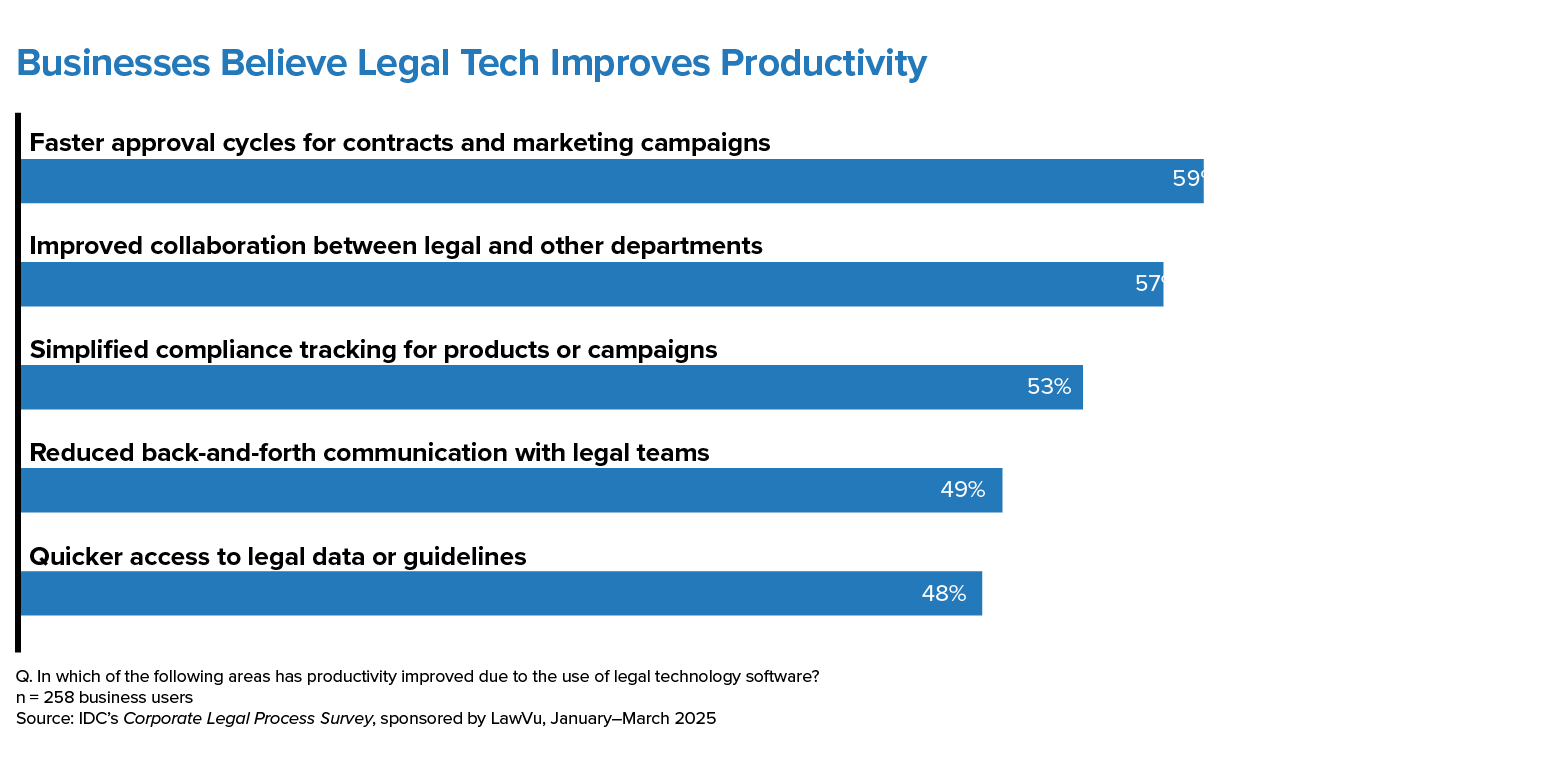
Reducing legal friction: IDC essential guidance
In light of overwhelming feedback from both in-house legal teams and their business partners, IDC research concludes that, to reduce legal friction, there is an urgent need for serious and ongoing investment in the legal function – positioning technology at the heart of legal operations.
In-house legal teams and their businesses should:
Embrace legal operations principles
First and foremost, organizations need to embrace legal operations principles – which means becoming more productive, cost-effective and data driven.
Adopt unified in-house legal technology
Organizations should prioritize the implementation of in-house legal technology. Deploying a CLM or e-billing solution isn’t enough – businesses need software that can act as a single source of truth, streamline all legal workflows, and facilitate self-service by the business.
And while securing budget can be challenging, IDC are clear that the return on investment (as a result of greater capacity, improved efficiency, and reduced outsourcing costs) should more than offset the expense of implementing a legal platform.
For in-house legal teams and business leaders, the opportunity is clear
At LawVu, we believe that legal friction is a significant and growing problem for businesses, causing loss of revenue, wasting valuable time and undermining strategic initiatives.
And as organizations face increasing pressure to grow and scale, the financial, operational and reputational risks tied to legal inefficiencies are becoming harder to ignore.
For in-house legal teams, the research findings are stark – but they are also encouraging.
With clear data now validating the challenges experienced by many on a daily basis, the results place them in a stronger position than ever to confidently make the case for investment in legal technology.
In doing so, in-house legal teams stand to not only free themselves from the drudgery of unskilled manual work – they also have a tremendous opportunity to rid themselves of outdated perceptions of legal as a cost center and reposition themselves as strategic enablers of business growth.
And for business leaders, addressing legal friction marks an even more critical opportunity.
With a simple investment in dedicated in-house legal technology, businesses can address a fundamental source of inefficiency which currently permeates every corner of the organization – ultimately accelerating not just legal outcomes, but those of the entire business.
Ready to reduce your legal friction?
Investing in a unified legal technology solution is the most effective path to reducing legal friction.
Fortunately, the LawVu legal workspace, a category-defining legal technology solution built specifically for in-house legal teams, exists to do just that.
To take the next step and learn how the LawVu legal workspace can reduce your own legal friction and transform outcomes across your business, click here.
Source: IDC White Paper, sponsored by LawVu, Legal Friction: The Real Cost to Your Business, #AP15041X, April 2025

